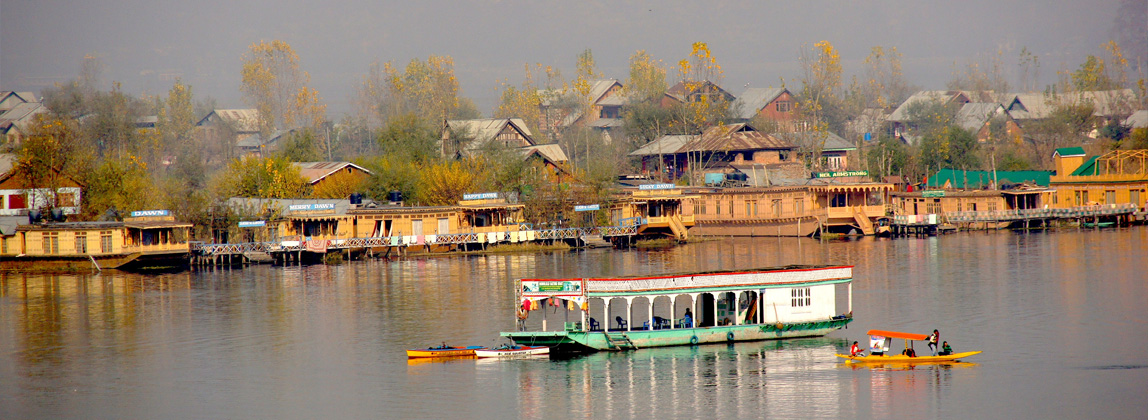


THE SUMMER CAPITAL of Jammu and Kashmir, Srinagar has charmed everyone for centuries through its sights, smells and sounds. Everything here is redolent of idyllic beauty, exotic charm and enigmatic history. The beauty of Srinagar can not only be seen in its lakes, gardens, springs, mountains, and the rich heritage, but also in the people who embrace the guests with open arms. And the city itself is a gateway to some of the most beautiful scenic places of the Indian subcontinent.
Srinagar is a riot of colors during summer when flowers bloom in its gardens laid by the Mughals. Known as Mughal Gardens, these should be the first in your itinerary. The Dal Lake promises you a scenic boat ride to visit these gardens.
You can start your Srinagar city sightseeing with Harwan Gardens in the Srinagar district. Lined with flower beds and massive Chinar trees, the garden has a beautiful canal flowing right through it. The place is an excellent picnic spot and people spend hours soaking the beauty of the gardens, or going for long walks.
Become a Mughal as you enter the Shalimar Gardens, near Srinagar City. Built by Mughal Emperor Jehangir, the celebrity royal gardens takes you back to the days of Mughal grandeur, with its cascades, watercourses, pavilions, Chinar trees an lawns. The high point of this four-terraced garden is the baradari, or summer house with its pillars of black marbles.
Another Mughal garden, the Nishat Bagh is located on the Dal Lake, about 2.5 kilornetres to the south of Shalimar Gardens. Designed by Asaf Khan, Nur Jahan's brother, it offers a magnificent view of mountains and the Dal Lake. You will be enamored by a central water channel, fountains and waterfalls surrounded by lush lawns and mighty chinars.
Laid out by Mughal Emperor Shah Jahan, the Chashma Shahi is a tastefully-done garden and offers you a magnificent view of the Dal Lake as well as the surrounding mountain ranges. Once a royal observatory, the Pan Mahal, built by Prince Dara Shikoh, can easily match Chashma Shahi as far as vistas are concerned.
Obviously you are riding the waters of the Dal Lake on your garden tour of Srinagar. As you proceed, the Shankaracharya Hill on the southern lake shore will attract your attention. At its top lies the Shankaracharya Temple, where Adi Shankaracharya is believed to have meditated. The aithul climb up the hill to pay obeisance to the great sage. All in all, a must for every tourist in Srinagar.
The 16th-century Han Parbat Fort, on Han Parbat hill, dominates Sninagar's skyline. The hill has been the seat of power, and houses many sacred shrines. The lower slopes of the hill are densely populated today, but remnants of a rampart built by Akhar remain, notably two gateways, the Sangin Darwaza and the Kathi Darwaza.
The major monuments of Srinagar, such as shrine of Dastgir Sahib in Khanyar, Rozabal Shrine, the compound of the impressive Khanqah of Khwaja Moinuddin Naqshbandi, Srinagar's central mosque, the Jami Masjid, Khanqah of Shah Hamdan, Pathar Masjid can be visited in a walking tour.
The Dal Lake itself demands a half-day tour on a shikara. If you start at daybreak, you can see the floating vegetable market, visit the island garden of Char Chinar, take a break at Hazratbal, traverse the Nagin Lake and the canals of the old Pandit quarter of Rainawari. An early morning shikara ride on the Jhelurn from Zero Bridge to the Chhathal Weir is also worth the time and money spent on it.
You can just go crazy on food in Srinagar. Never miss out on the stuff offered in houseboats, if you have rightly taken the option to holiday in one of these well- appointed floating hotels. Fish eaters can gorge on the trout, carp or Kashmiri machhli (fish). Kashmiri food by itself is scrumptious— both the vegetarian and non-vegetarian platter.
The best time to visit Srinagar is from March to November. If you are not in the lake area, the best option is to take a taxi to tour Srinagar. Carry your identification proof if you are planning to visit Srinagar.